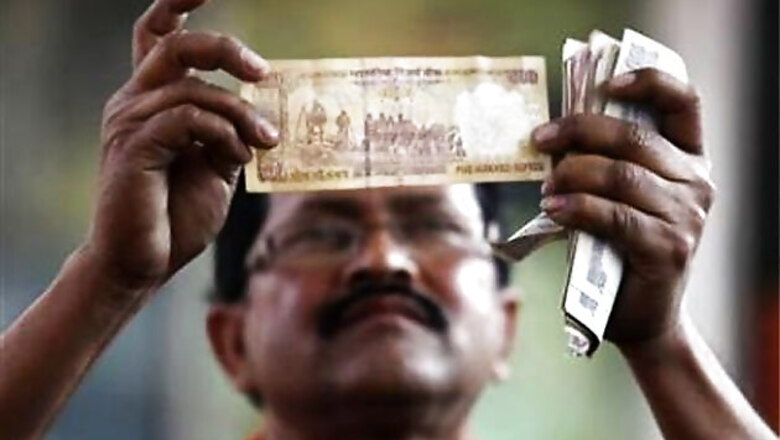
views
New Delhi: Surging capital inflows, booming stock markets and a fast-appreciating currency suggest the India story is again shining after a dismal 2011.
Dig a little deeper, and problems afflicting Asia's third-largest economy remain largely unabated and unaddressed. Inflationary risks remain and a political logjam continues to hem in reforms, clouding the economic outlook.
"Nothing has happened on the policy front to justify this mood," said Andrew Kenningham, an economist at Capital Economics in London. "Growth prospects are not looking good by historical standards."
The union government on Tuesday cut the growth estimate for the current fiscal year that ends in March to 6.9 per cent from a revised forecast of around 7.5 per cent issued in December, sharply below the 8.4 per cent growth of the last fiscal year.
Still, the BSE Sensex is up nearly 15 per cent this year while the rupee has risen about 8 per cent from its 2011 close, with both clocking the sharpest gains in more than a decade.
An improved global funding environment, relatively attractive valuations of Indian equities and hopes for rate cuts by the central bank have lured foreign institutions. They are net buyers of $3.2 billion Indian equities this year after having sold $357 million last year.
"The rally at this stage may be more a reflection of foreign portfolio flows and an appreciation of the rupee," said Sanjay Sinha, a veteran fund manager who founded Citrus Advisors, an investment advisory firm.
"This in itself may be in an anticipation that the twin factors of a rate cut from April and bold economic policies may actually herald the resurgence of the economy. Therefore, data may follow but the markets may have rallied ahead of them."
Valuations at the end of 2011 were 12-13 times estimated earnings for the fiscal year that ends in March 2013, compared with a 10-year average of 15, said Rakesh Arora, managing director at Macquarie Equities Research in Mumbai.
The Reserve Bank of India (RBI) has signalled that it is finished raising interest rates after 13 increases between March 2010 and October 2011, to the relief of companies and banks. A rate cut is widely expected by the end of June, if not sooner.
The rupee's recovery has been fuelled in part by measures the central bank took to stabilize the exchange rate.
"It is a feel-good rally," said Jagannadham Thunuguntla, head of research at SMC Investments and Advisors Ltd.
Macroeconomic indicators are recently looking better.
Industrial output has recovered from a record slump and the manufacturing and services sectors continue to pick up pace. Inflation slipped below 8 percent for the first time in two years in December and is on track to fall to the central bank's 7 per cent target by the end of the fiscal year.
Premature
Many India-watchers warn the euphoria is premature.
Inflation is indeed down smartly, falling to a two-year low of 7.47 per cent, but that is due almost entirely to a drop in food inflation that is widely seen as unsustainable.
Non-food manufactured inflation eased by just 0.2 percentage points from 7.9 per cent in November to 7.7 per cent in December.
All of this means that the RBI may not be in a hurry to slash interest rates.
"We don't expect the RBI to be aggressive in easing rates as inflation worries are still not completely mitigated. We expect it to be cautious in easing interest rates," said Siddhartha Sanyal, an economist at Barclays Capital in Mumbai.
Meanwhile, the policy environment in New Delhi remains muddled, with the Congress party government of Prime Minister Manmohan Singh weakened by corruption scandals and facing a tough election in Uttar Pradesh, India's most populous state.
A negative outcome for Congress next month in the election could further weaken it and exacerbate political gridlock that has already stalled reforms including a goods and services tax (GST) and foreign direct investment in multi-brand retail.
Before the global financial crisis of 2008, India's growth capacity was estimated at around 8.5 per cent. Sluggish capital investment since then means India can now sustain just 7 or 7.5 per cent growth without overheating, economists say.
"From the last quarter, there has been no push in terms of policies to help get investments moving on the ground," said MS Unnikrishnan, managing director at Thermax Ltd, which makes and installs heating and pollution control gear.
"Share market prices and the movement in the rupee are no indication of what is happening on the ground," he added.
Fiscal fissures
Public finances remain strained. RBI Governor Duvvuri Subbarao last month urged New Delhi to adopt greater fiscal discipline, saying a lack of credible fiscal consolidation would constrain it from lowering rates.
The global picture remains mixed. While improving prospects in the United States have driven optimism, most recently in a better-than-expected jobs report, the ongoing euro zone debt crisis weighs on sentiment and puts pressure on India's exports, and in turn its current account deficit.
Morgan Stanley wrote in a Monday note that ongoing fiscal and current account deficits will continue to pressure the rupee against the dollar over the long term.
"As the economy undergoes an extensive deleveraging process, we expect Indian equities and credits to underperform against their regional and emerging market peers during 2012," it said.
Year to forget
Calendar 2011 was a year policymakers would rather forget.
Inflation stayed stubbornly high, prompting rate hikes that mainly served to dampen growth. As the economy lost steam, public finances weakened. New Delhi is on track to fall short of its aim to trim the fiscal deficit to 4.6 per cent of GDP.
Political gridlock after a wave of scandals means investment bottlenecks persist, dampening investor sentiment and eroding asset quality in the infrastructure sector as projects stall.
Shares plunged, ending the year with their first annual fall in three years. A record sell-off in equity markets hammered the rupee, which lost nearly 16 per cent against the US dollar, rendering it the worst performer in Asia.
"Foreign inflows are coming in on the fact that the interest rate cycle has peaked in India and economic situation has reached a trough," said Sinha of Citrus Advisors.
"To sustain them from here on requires action on policy reforms. If hopes of economic reforms don't materialize, there are good chances of these inflows drying up," he said.

















Comments
0 comment